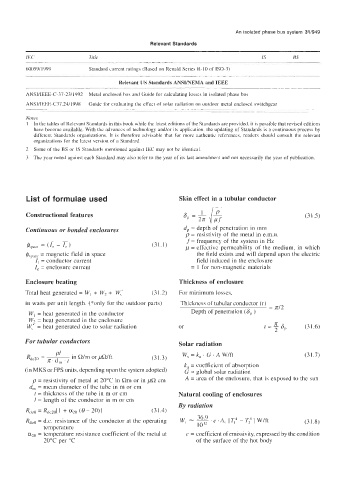Page 1004 - Industrial Power Engineering and Applications Handbook
P. 1004
An isolated phase bus system 31/949
Relevant Standards
IEC Title IS BS
6005911999 Standard current ratings (Based on Renald Series R-10 of ISO-3)
Relevant US Standards ANSIINEMA and IEEE
ANSInEEE-C-37-23/1992 Metal enclosed bus and Guide for calculating losses in isolated phase bus
ANSVIEEE-C37.24/1998 Guide for evaluating the effect of solar radiation on outdoor metal enclosed switchgea
Notes
1 In the tables of Relevant Standards in this book while the latest editions of the Standards are provided, it is possible that revised editions
have become available. With the advances of technology andor its application, the updating of Standards is a continuous process by
different Standards organizations. It is therefore advisable that for more authentic references, readers should consult the relevant
organizations for the latest version of a Standard.
2 Some of the BS or IS Standards mentioned against IEC may not be identical.
3 The year noted against each Standard may also refer to the year of its last amendment and not necessarily the year of publication.
List of formulae used Skin effect in a tubular conductor
Constructional features (31.5)
Continuous or bonded enclosures dp = depth of penetration in mm
p = resistivity of the metal in e.m.u.
f = frequency of the system in Hz
@space (I, - I,) (31.1) p = effective permeability of the medium, in which
= magnetic field in space the field exists and will depend upon the electric
I, = conductor current field induced in the enclosure
I, = enclosure current = 1 for non-magnetic materials
Enclosure heating Thickness of enclosure
Total heat generated = W, + W2 + W,* (31.2) For minimum losses,
in watts per unit length. (*only for the outdoor parts) Thickness of tubular conductor (t) = 7d2
W1 = heat generated in the conductor Depth of penetration (6, )
W, = heat generated in the enclosure
n
W,* = heat generated due to solar radiation or t=-ap (31.6)
2
For tubular conductors Solar radiation
Rdc20 = P1 in Q/m or pQ/ft (31.3) W, = k, . G . A W/ft (3 1.7)
k, = coefficient of absorption
(in MKS or FPS units, depending upon the system adopted) G = global solar radiation
p = resistivity of metal at 20°C in Qm or in pQ cm A = area of the enclosure, that is exposed to the sun
d,,, = mean diameter of the tube in m or cm
t = thickness of the tube in m or cm Natural cooling of enclosures
1 = length of the conductor in m or cm
By radiation
&ice = Rdc20[1 + a20 (6 - 2011 (31.4)
Rdce = d.c. resistance of the conductor at the operating (31.8)
temperature
a20 = temperature resistance coefficient of the metal at e = coefticient of emissivity, expressed by the condition
20°C per "C of the surface of the hot body

